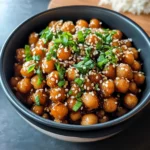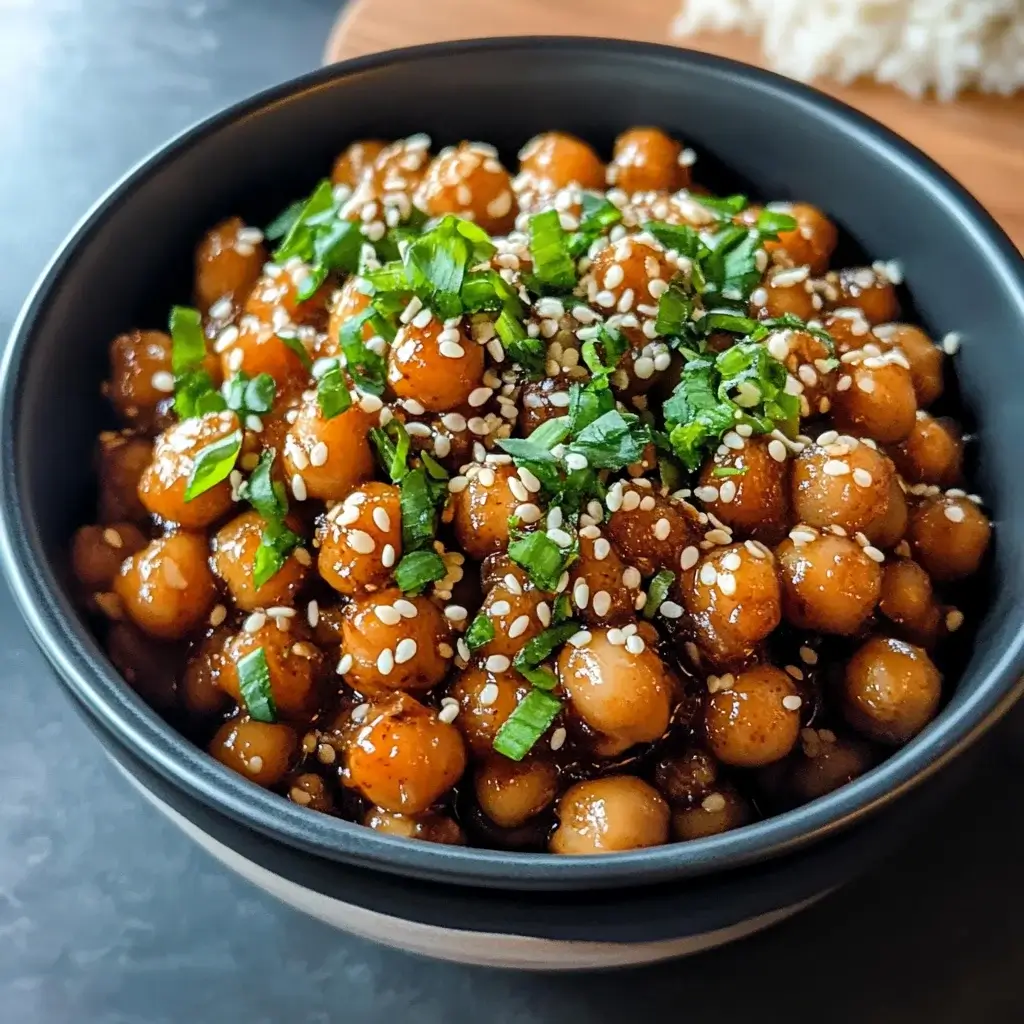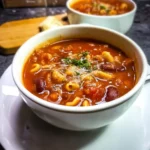The aroma of toasted sesame seeds and a hint of ginger wafting from the kitchen – that’s the signal in our home that something truly delicious is about to be served. And more often than not, that delightful scent heralds the arrival of Vegetarian Sticky Sesame Chickpeas. This dish has become an absolute weeknight champion for us. It’s the kind of meal that manages to be both incredibly satisfying and surprisingly healthy, all while being ridiculously easy to throw together. Even my meat-loving partner admits that this chickpea dish is packed with so much flavor and texture that he doesn’t miss meat at all! What I personally adore is how versatile it is. Serve it over fluffy rice, quinoa, or even nestled into lettuce wraps for a lighter option. It’s a dish that feels equally at home for a quick family dinner or a casual get-together with friends. The sticky, savory-sweet sauce coats the chickpeas perfectly, creating a symphony of flavors and textures that’s simply irresistible. If you’re on the hunt for a vegetarian or vegan recipe that’s bursting with flavor, requires minimal effort, and is guaranteed to be a crowd-pleaser, then stop right here. These Vegetarian Sticky Sesame Chickpeas are about to become your new go-to for flavorful and fuss-free meals.
Ingredients for Irresistible Vegetarian Sticky Sesame Chickpeas
To create the most delectable Vegetarian Sticky Sesame Chickpeas, you’ll need a selection of ingredients that work in harmony to build layers of flavor and texture. The key to this recipe is balancing the savory, sweet, and umami notes, while ensuring the chickpeas become perfectly sticky and coated in the luscious sesame sauce. Here’s a comprehensive list of ingredients you’ll need, with notes on substitutions and variations to help you customize this dish to your liking:
For the Sticky Sesame Chickpeas:
- 2 cans (15 ounces each) Chickpeas, Drained and Rinsed: Chickpeas are the star of the show, providing a hearty, protein-rich base. Canned chickpeas are convenient and work perfectly in this recipe. Ensure they are well-drained and rinsed to remove excess liquid and sodium. You can also use about 3 cups of cooked chickpeas if you prefer to cook them from scratch.
- 2 Tablespoons Olive Oil or Sesame Oil: Oil is used for sautéing and adds flavor. Olive oil is a versatile option, while sesame oil enhances the sesame flavor of the dish. For a richer sesame flavor, you can use sesame oil, or a combination of both.
- 2-3 Cloves Garlic, Minced: Garlic provides a pungent, savory base flavor that is essential in Asian-inspired dishes. Freshly minced garlic is recommended for the best flavor.
- 1 inch Ginger, Freshly Grated or Minced: Fresh ginger adds a warm, zesty, and slightly spicy note that balances the sweetness and savoriness of the sauce. Freshly grated or minced ginger is crucial for the authentic flavor profile. You can use ginger paste in a pinch, but fresh ginger is superior.
- ¼ Cup Soy Sauce or Tamari (for Gluten-Free): Soy sauce provides umami and saltiness, forming the savory backbone of the sauce. Use regular soy sauce or low-sodium soy sauce to control the salt level. For a gluten-free option, use tamari, which is a type of soy sauce typically made without wheat.
- ¼ Cup Maple Syrup or Honey (for Vegan Option): Maple syrup adds sweetness and contributes to the sticky texture of the sauce. For a vegan version, use maple syrup or agave nectar. For a non-vegan version, honey can be used for a slightly different flavor profile. Adjust the amount based on your desired level of sweetness.
- 2 Tablespoons Rice Vinegar: Rice vinegar adds a subtle tanginess and acidity that balances the sweetness and richness of the sauce. It also helps to brighten the overall flavor. You can use seasoned or unseasoned rice vinegar.
- 1 Tablespoon Cornstarch or Arrowroot Powder (for Gluten-Free): Cornstarch or arrowroot powder is used as a thickening agent to create the sticky sauce. Cornstarch is a common choice, while arrowroot powder is a gluten-free alternative that works equally well.
- 2 Tablespoons Water: Water is used to create a slurry with the cornstarch/arrowroot powder, which helps to thicken the sauce smoothly and evenly.
- 2 Tablespoons Sesame Seeds, Toasted: Sesame seeds are crucial for the signature sesame flavor and add a nutty crunch. Toasted sesame seeds have a much more intense and aromatic flavor. Toast them in a dry skillet over medium heat until lightly golden and fragrant, being careful not to burn them.
- Optional: Red Pepper Flakes, to taste (for a touch of spice): Red pepper flakes add a kick of heat and spice to balance the sweetness and savoriness. Adjust the amount to your spice preference, or omit if you prefer a milder dish.
- Optional Garnishes (for serving):
- Chopped Green Onions or Scallions: Green onions add a fresh, mild oniony flavor and a pop of color as a garnish.
- Extra Toasted Sesame Seeds: For visual appeal and an extra burst of sesame flavor.
Equipment:
- Large Skillet or Wok: A large skillet or wok is ideal for cooking the chickpeas and sauce, providing enough surface area for even cooking and sauce reduction.
- Large Bowl: For tossing the chickpeas with cornstarch (optional step for extra crispiness).
- Small Bowl: For mixing the sauce ingredients.
- Measuring Cups and Spoons: For accurate ingredient measurement.
- Spatula or Wooden Spoon: For stirring and cooking the chickpeas and sauce.
- Garlic Press or Knife: For mincing garlic.
- Grater or Knife: For grating or mincing ginger.
This detailed ingredient list ensures you have everything you need to create incredibly flavorful and perfectly textured Vegetarian Sticky Sesame Chickpeas. Remember, using fresh, high-quality ingredients will always yield the best results.
Step-by-Step Instructions for Making Vegetarian Sticky Sesame Chickpeas
Creating delicious Vegetarian Sticky Sesame Chickpeas is surprisingly simple and quick! Follow these detailed, step-by-step instructions to ensure you achieve perfectly sticky, flavorful chickpeas every time. We’ll break down each stage, from prepping the chickpeas to achieving that signature sticky sesame glaze.
Step 1: Prepare the Chickpeas (Optional Crispiness Step)
- Drain and Rinse Chickpeas: Open the cans of chickpeas and drain them thoroughly in a colander. Rinse them well under cold running water to remove any excess liquid and can residue. Allow them to drain completely.
- Pat Chickpeas Dry (Recommended): For slightly crispier chickpeas, pat them as dry as possible with paper towels. This helps them to brown better in the skillet.
- Optional: Toss with Cornstarch (For Extra Crispiness): For even crispier chickpeas, you can toss them with 1 tablespoon of cornstarch or arrowroot powder in a large bowl. This creates a light coating that helps them crisp up during cooking. Ensure the chickpeas are evenly coated. This step is optional but recommended if you prefer a bit of crispiness to your chickpeas.
Step 2: Prepare the Sticky Sesame Sauce
- Whisk Sauce Ingredients: In a small bowl, whisk together the soy sauce (or tamari), maple syrup (or honey), rice vinegar, cornstarch (or arrowroot powder), and water. Whisk until the cornstarch is fully dissolved and the sauce is smooth. Set aside. Having the sauce pre-mixed and ready to go streamlines the cooking process.
Step 3: Sauté Garlic and Ginger
- Heat Oil in Skillet: Place a large skillet or wok over medium heat. Add the olive oil or sesame oil (or a combination) and let it heat up until it shimmers slightly.
- Sauté Garlic and Ginger: Add the minced garlic and grated or minced ginger to the hot skillet. Sauté for about 1 minute, stirring constantly, until fragrant. Be careful not to burn the garlic and ginger, as they can become bitter. Sautéing them briefly in oil releases their aromatic oils and enhances the flavor of the dish.
Step 4: Cook the Chickpeas
- Add Chickpeas to Skillet: Add the drained and rinsed (and optionally cornstarch-coated) chickpeas to the skillet with the sautéed garlic and ginger.
- Cook Chickpeas: Cook the chickpeas for 5-7 minutes, stirring occasionally, until they are heated through and slightly browned. If you tossed them in cornstarch, they should start to develop a light crispiness. Cooking them for a bit before adding the sauce helps to improve their texture and allows them to absorb the flavors.
Step 5: Add Sticky Sesame Sauce and Simmer
- Pour Sauce into Skillet: Pour the prepared sticky sesame sauce over the chickpeas in the skillet.
- Bring to a Simmer: Increase the heat slightly to medium-high and bring the sauce to a simmer, stirring constantly.
- Simmer and Thicken: Reduce the heat back to medium and simmer for 3-5 minutes, or until the sauce has thickened and become glossy and sticky, coating the chickpeas evenly. Stir frequently to prevent sticking and ensure even sauce distribution. As the sauce simmers, the cornstarch activates, creating that signature sticky glaze.
Step 6: Finish and Serve
- Stir in Toasted Sesame Seeds: Remove the skillet from the heat and stir in the toasted sesame seeds. Toss to coat the chickpeas evenly with the sesame seeds.
- Optional: Add Red Pepper Flakes: If using red pepper flakes for a touch of spice, stir them in now, or sprinkle them over the finished dish as a garnish.
- Garnish and Serve: Garnish with chopped green onions or scallions and extra toasted sesame seeds, if desired. Serve immediately over rice, quinoa, noodles, or your choice of base.
Following these step-by-step instructions will guide you to create perfectly cooked Vegetarian Sticky Sesame Chickpeas with a luscious, flavorful, and truly irresistible sticky sesame glaze. Enjoy the process and the delicious results!
Nutrition Facts for Vegetarian Sticky Sesame Chickpeas
Understanding the nutritional profile of your meals is important for making informed dietary choices. Vegetarian Sticky Sesame Chickpeas are not only delicious but also offer a good source of plant-based protein, fiber, and various vitamins and minerals. Here’s an estimated breakdown of the nutrition facts per serving:
Servings: This recipe is designed to serve approximately 4-6 servings as a main dish, or 6-8 servings as a side dish. Serving sizes can vary depending on appetite and accompanying dishes.
Estimated Nutrition Facts Per Serving (Based on 4 Servings and Approximate Ingredients):
- Calories: Approximately 300-350 calories per serving. This is an estimate and can vary based on serving size, specific brands of ingredients, and the amount of oil used.
- Protein: Approximately 10-12 grams per serving. Chickpeas are a good source of plant-based protein, contributing to satiety and muscle maintenance.
- Fat: Approximately 10-15 grams per serving. Fat content comes primarily from olive oil or sesame oil and sesame seeds. These are mostly healthy fats.
- Saturated Fat: Approximately 1-2 grams per serving. Saturated fat content is relatively low.
- Cholesterol: Approximately 0 mg per serving. This recipe is cholesterol-free.
- Carbohydrates: Approximately 40-50 grams per serving. Carbohydrates come primarily from chickpeas and maple syrup/honey.
- Fiber: Approximately 8-10 grams per serving. Chickpeas are an excellent source of dietary fiber, which is beneficial for digestion, blood sugar control, and satiety.
- Sugar: Approximately 15-20 grams per serving. Sugar content comes primarily from maple syrup or honey. You can adjust the amount of sweetener to control sugar levels. Naturally occurring sugars are also present in chickpeas and other ingredients.
- Sodium: Approximately 500-700 mg per serving. Sodium content comes mainly from soy sauce. Using low-sodium soy sauce can significantly reduce the sodium content.
- Vitamins and Minerals: This dish is a good source of:
- Manganese: Chickpeas are rich in manganese, an essential mineral involved in bone health, metabolism, and antioxidant defense.
- Folate (Vitamin B9): Chickpeas are a good source of folate, important for cell growth and development, especially during pregnancy.
- Iron: Chickpeas provide iron, which is essential for oxygen transport and energy production. Plant-based iron is best absorbed when consumed with Vitamin C.
- Phosphorus: Chickpeas contain phosphorus, important for bone health, energy production, and cell function.
- Copper: Chickpeas are a source of copper, which is involved in iron absorption, energy production, and nerve function.
- Magnesium: Chickpeas provide magnesium, important for muscle and nerve function, blood sugar control, and blood pressure regulation.
Important Notes:
- These are estimated values and can vary. For more precise nutritional information, you can use online nutrition calculators and input the exact brands and quantities of ingredients you use.
- This dish is a relatively balanced vegetarian/vegan meal, providing a good source of protein, healthy fats, carbohydrates, and fiber, along with various vitamins and minerals.
- To make it even healthier, you can:
- Use low-sodium soy sauce to reduce sodium content.
- Reduce the amount of maple syrup or honey to lower sugar content.
- Serve with whole grains like brown rice or quinoa to increase fiber and nutrient density.
- Pair with a side of steamed or roasted vegetables to add more vitamins, minerals, and fiber.
By understanding the nutritional profile, you can appreciate that Vegetarian Sticky Sesame Chickpeas are not only a delicious and satisfying meal but also a nutritious choice that can be part of a healthy eating plan.
Preparation Time for Vegetarian Sticky Sesame Chickpeas
One of the many appealing aspects of Vegetarian Sticky Sesame Chickpeas is its quick preparation time, making it an excellent option for busy weeknights when you crave a flavorful and healthy meal without spending hours in the kitchen. Here’s a breakdown of the estimated time involved:
Total Preparation Time: Approximately 25-30 minutes
This total time can be further divided into:
- Prep Time: 10-15 minutes
- Chickpea Draining and Rinsing (2-3 minutes): Draining and rinsing canned chickpeas.
- Vegetable Prep (Garlic and Ginger) (5-7 minutes): Mincing garlic and grating or mincing ginger.
- Sauce Whisking (2-3 minutes): Whisking together the sauce ingredients.
- Optional Chickpea Drying and Cornstarch Coating (3-5 minutes): If you choose to pat dry and coat the chickpeas in cornstarch for extra crispiness.
- Toasting Sesame Seeds (2-3 minutes): Toasting sesame seeds (can be done concurrently with other prep).
- Cook Time: 15-20 minutes
- Sautéing Garlic and Ginger (1-2 minutes): Sautéing aromatics.
- Cooking Chickpeas (5-7 minutes): Cooking chickpeas in the skillet.
- Simmering in Sauce (5-7 minutes): Simmering chickpeas in the sticky sesame sauce until thickened.
- Finishing and Garnishing (2-3 minutes): Stirring in sesame seeds, garnishing, and serving.
Tips to Reduce Preparation Time:
- Use Pre-Mined Garlic and Ginger (Jarred or Paste): While fresh is best, using pre-minced garlic and ginger paste can save a few minutes of prep time.
- Skip Chickpea Drying and Cornstarch Coating: If you are not concerned about achieving maximum crispiness, you can skip patting the chickpeas dry and tossing them in cornstarch.
- Multitask: While the skillet is heating up, you can mince the garlic and ginger and whisk together the sauce ingredients. While the chickpeas are cooking, you can prepare your chosen base (rice, quinoa, etc.) or side dishes.
- Toast Sesame Seeds Ahead of Time: You can toast sesame seeds in larger batches and store them in an airtight container for future use, saving time during recipe preparation.
Even with the optional crispiness step, this Vegetarian Sticky Sesame Chickpea recipe remains a quick and efficient meal to prepare. The active cooking time is relatively short, making it perfect for a satisfying and flavorful weeknight dinner.
How to Serve Your Vegetarian Sticky Sesame Chickpeas
Vegetarian Sticky Sesame Chickpeas are incredibly versatile and can be served in numerous ways to create a complete and satisfying meal. Here are several serving suggestions to inspire you and elevate your dining experience:
Serving Bases (Grains and Alternatives):
- Steamed Rice (White or Brown): Classic and comforting, steamed rice is the most traditional base for sesame chickpeas. White rice offers a neutral flavor and fluffy texture, while brown rice provides more fiber and a nutty taste.
- Quinoa: For a protein-rich and gluten-free option, serve over quinoa. Quinoa’s slightly nutty flavor and fluffy texture complement the sticky chickpeas beautifully.
- Noodles (Egg Noodles, Ramen Noodles, or Rice Noodles): Toss the sticky sesame chickpeas with cooked noodles for a satisfying and flavorful noodle bowl. Egg noodles provide richness, ramen noodles offer chewiness, and rice noodles are a gluten-free option.
- Cauliflower Rice: For a low-carb and grain-free option, serve over cauliflower rice. Cauliflower rice is light and absorbs the flavorful sauce nicely.
- Lettuce Wraps: For a lighter and refreshing option, serve the sticky sesame chickpeas in crisp lettuce cups (like butter lettuce or romaine lettuce). This is a great choice for appetizers or a light lunch.
- Sweet Potatoes (Baked or Roasted): Top baked or roasted sweet potatoes with sticky sesame chickpeas for a hearty and flavorful meal. The sweetness of the sweet potato complements the savory sesame chickpeas.
Side Dish Pairings (Vegetables and Salads):
- Steamed or Roasted Broccoli: Broccoli florets, steamed or roasted until tender-crisp, provide a healthy and complementary side. The slight bitterness of broccoli balances the sweetness of the sauce.
- Steamed or Roasted Asparagus: Asparagus spears, steamed or roasted, offer a delicate and slightly grassy flavor that pairs well with sesame chickpeas.
- Stir-Fried Vegetables: A simple stir-fry of mixed vegetables like bell peppers, snow peas, carrots, and bok choy adds extra nutrients and textures.
- Edamame (Steamed or Roasted): Steamed or roasted edamame pods or shelled edamame provide extra protein and a satisfying snack or side.
- Asian Slaw: A refreshing Asian slaw with shredded cabbage, carrots, and a sesame-ginger dressing offers a crunchy and tangy counterpoint to the sticky chickpeas.
- Cucumber Salad: A simple cucumber salad with rice vinegar, sesame oil, and a pinch of sugar provides a cooling and refreshing side.
Garnishes and Toppings (Flavor Enhancers and Visual Appeal):
- Chopped Green Onions or Scallions: A must-have garnish that adds freshness and a mild oniony flavor.
- Extra Toasted Sesame Seeds: Enhances the sesame flavor and adds visual appeal and texture.
- Red Pepper Flakes: For a sprinkle of extra heat and visual contrast.
- Fresh Cilantro or Parsley, Chopped: Adds freshness and herbaceous notes.
- Sriracha or Chili Garlic Sauce: For those who love extra spice, offer sriracha or chili garlic sauce on the side for drizzling.
- Lime Wedges: A squeeze of fresh lime juice brightens up the flavors and adds a zesty touch.
Serving Styles:
- Bowls: Create flavorful bowls by layering your chosen base (rice, quinoa, noodles, etc.) with sticky sesame chickpeas and your preferred side dishes and garnishes.
- Plates: Serve as a main dish on plates with rice or quinoa alongside steamed or roasted vegetables.
- Family Style: Serve the sticky sesame chickpeas in a large serving dish in the center of the table, allowing everyone to serve themselves and customize their plates with various bases and side dishes.
By offering a variety of bases, side dishes, and garnishes, you can create a diverse and customizable Vegetarian Sticky Sesame Chickpea meal that caters to different tastes and preferences. Encourage your diners to mix and match to create their perfect plate!
Additional Tips for the Best Vegetarian Sticky Sesame Chickpeas
To ensure your Vegetarian Sticky Sesame Chickpeas are consistently delicious and impressive, here are five additional tips and tricks to keep in mind:
1. Toast Your Sesame Seeds Properly:
- Toasting is Crucial: Toasted sesame seeds are essential for unlocking their full flavor potential. Raw sesame seeds lack the nutty aroma and depth of flavor that toasted seeds provide.
- Dry Toasting Method: The best way to toast sesame seeds is in a dry skillet over medium heat. Place the sesame seeds in a dry skillet and cook, stirring frequently, for 2-4 minutes, or until they are lightly golden brown and fragrant. Watch them closely, as they can burn quickly.
- Aroma Indicator: You’ll know the sesame seeds are toasted when they become fragrant and start to pop slightly. Remove them from the skillet immediately and transfer them to a plate to cool, as they will continue to cook in the hot skillet.
2. Don’t Overcook the Sauce:
- Simmer Until Thickened: Simmer the sticky sesame sauce until it thickens to your desired consistency and becomes glossy. The sauce should be able to coat the back of a spoon.
- Avoid Over-Reduction: Be careful not to over-reduce the sauce, as it can become too thick and syrupy, and may lose its glossy shine. Simmering for 3-5 minutes after adding the sauce is usually sufficient. The sauce will also thicken slightly as it cools.
- Adjust Cornstarch/Arrowroot: If your sauce is not thickening enough, you can mix a little more cornstarch or arrowroot powder (about ½ teaspoon) with a tablespoon of cold water to make a slurry, and then whisk it into the simmering sauce. Simmer for another minute or two until thickened.
3. Customize the Spice Level:
- Red Pepper Flakes for Heat: Red pepper flakes are an easy way to add a touch of spice to your sticky sesame chickpeas. Start with a small amount (¼ teaspoon) and add more to taste.
- Fresh Chili or Sriracha: For a more intense heat, you can add a finely minced fresh red chili pepper (like Thai chili or bird’s eye chili) when sautéing the garlic and ginger. You can also drizzle sriracha or chili garlic sauce over the finished dish for individual spice customization.
- Consider Your Audience: Be mindful of your audience’s spice preferences when adjusting the heat level. You can always serve hot sauce on the side for those who want extra spice.
4. Fresh Ginger is Key:
- Fresh Ginger Flavor: Fresh ginger provides a much brighter, more pungent, and complex flavor compared to dried ginger powder. Fresh ginger is crucial for the authentic flavor profile of this dish.
- Grate or Mince Finely: Grate fresh ginger using a microplane or fine grater, or mince it very finely with a knife. Grating releases more of its flavorful juices.
- Ginger Paste (In a Pinch): If you don’t have fresh ginger, you can use ginger paste as a substitute, but fresh ginger is highly recommended for the best results.
5. Make it a Complete Meal with Vegetables:
- Add Vegetables to the Skillet: To make your Vegetarian Sticky Sesame Chickpeas a more complete and nutritionally balanced meal, consider adding vegetables directly to the skillet along with the chickpeas.
- Vegetable Options: Good vegetable additions include broccoli florets, bell pepper strips, snow peas, sliced carrots, or edamame. Add them to the skillet after sautéing the garlic and ginger, and cook them until tender-crisp before adding the chickpeas and sauce. This one-pan approach simplifies cooking and adds extra nutrients and fiber to your meal.
By keeping these tips in mind, you can consistently create a perfectly balanced, flavorful, and texturally satisfying Vegetarian Sticky Sesame Chickpea dish that will impress everyone who tries it.
Frequently Asked Questions (FAQ) About Vegetarian Sticky Sesame Chickpeas
Here are five frequently asked questions about making and serving Vegetarian Sticky Sesame Chickpeas, along with detailed answers to help you master this recipe and address common queries:
Q1: Can I make Vegetarian Sticky Sesame Chickpeas gluten-free?
A: Yes, absolutely! It’s very easy to make this recipe gluten-free with just a few simple substitutions.
- Gluten-Free Soy Sauce (Tamari): The most important substitution is to use tamari instead of regular soy sauce. Tamari is a type of soy sauce that is typically made without wheat and is therefore gluten-free. Ensure you choose a certified gluten-free tamari to be certain.
- Gluten-Free Thickener (Arrowroot Powder): While cornstarch is naturally gluten-free, some individuals with gluten sensitivities prefer to use arrowroot powder as a thickener. Arrowroot powder works just as effectively as cornstarch in this recipe and is a guaranteed gluten-free option.
- Check Other Ingredients: Double-check all other ingredients to ensure they are gluten-free, although most of the other ingredients in this recipe (chickpeas, garlic, ginger, maple syrup/honey, rice vinegar, sesame seeds, oil, etc.) are naturally gluten-free.
By using tamari and arrowroot powder, you can confidently enjoy a delicious and completely gluten-free version of Vegetarian Sticky Sesame Chickpeas.
Q2: Can I use dried chickpeas instead of canned chickpeas?
A: Yes, you can definitely use dried chickpeas if you prefer. Cooking chickpeas from scratch can offer a slightly nuttier flavor and allows you to control the sodium level.
- Cooking Dried Chickpeas:
- Soaking: Soak 1 cup of dried chickpeas overnight (or for at least 8 hours) in plenty of water.
- Cooking: Drain and rinse the soaked chickpeas. Place them in a pot and cover with fresh water (about 4 cups). Bring to a boil, then reduce heat and simmer for about 1-1.5 hours, or until the chickpeas are tender. You should be able to easily mash one with a fork.
- Yield: 1 cup of dried chickpeas will yield approximately 3 cups of cooked chickpeas, which is equivalent to two 15-ounce cans.
- Using Cooked Chickpeas in the Recipe: Once your chickpeas are cooked and drained, you can proceed with Step 3 of the recipe instructions, sautéing the garlic and ginger, and continue as directed.
- Time Consideration: Using dried chickpeas will significantly increase the overall preparation time due to the soaking and cooking process. Canned chickpeas are much more convenient for a quicker meal.
Q3: How long do Vegetarian Sticky Sesame Chickpea leftovers last?
A: Leftover Vegetarian Sticky Sesame Chickpeas can be stored in the refrigerator for up to 3-4 days and still be safely enjoyed.
- Storage Instructions: Allow the cooked chickpeas to cool completely before transferring them to an airtight container. Store in the refrigerator.
- Reheating Methods:
- Microwave: The quickest way to reheat leftovers is in the microwave. Heat in 1-minute intervals, stirring in between, until heated through.
- Skillet: For a slightly better texture, you can reheat the chickpeas in a skillet over medium-low heat. Add a splash of water or broth if needed to prevent them from drying out. Heat until warmed through, stirring occasionally.
- Oven (Less Recommended): Reheating in the oven is less ideal as it can dry out the chickpeas. If you choose to reheat in the oven, cover them with foil and reheat at 350°F (175°C) until warmed through.
- Texture Change: The texture of the chickpeas may soften slightly upon reheating, and they may lose some of their crispiness if you used the cornstarch coating method. However, the flavor should remain delicious.
Q4: Can I make this recipe spicier or sweeter?
A: Yes, absolutely! This recipe is easily customizable to adjust the spice level and sweetness to your preference.
- Making it Spicier:
- Increase Red Pepper Flakes: Add more red pepper flakes to the recipe for a noticeable increase in heat.
- Fresh Chili Peppers: Incorporate finely minced fresh chili peppers (like Thai chilies, serrano peppers, or jalapeños) when sautéing the garlic and ginger.
- Hot Sauce: Drizzle sriracha, chili garlic sauce, or your favorite hot sauce over the finished dish or serve it on the side.
- Cayenne Pepper: Add a pinch of cayenne pepper to the sauce mixture for a general heat.
- Making it Sweeter:
- Increase Maple Syrup or Honey: Add more maple syrup (for vegan) or honey (for non-vegan) to the sauce mixture to increase the sweetness. Start with an extra tablespoon and adjust to taste.
- Brown Sugar: Substitute a portion of the maple syrup/honey with brown sugar for a deeper, molasses-like sweetness.
Taste the sauce before adding it to the chickpeas and adjust the spice and sweetness levels to your liking. Remember, you can always add more spice or sweetness, but it’s harder to remove it once added, so start with smaller adjustments.
Q5: Can I add other vegetables to this recipe?
A: Yes, definitely! Adding other vegetables is a great way to boost the nutritional value and create a heartier, more complete meal with your Vegetarian Sticky Sesame Chickpeas.
- Vegetable Additions:
- Broccoli Florets: Add broccoli florets to the skillet after sautéing the garlic and ginger and cook until tender-crisp before adding the chickpeas and sauce.
- Bell Peppers: Sliced bell peppers (any color) can be added along with broccoli or used as a substitute.
- Snow Peas or Snap Peas: Add snow peas or snap peas towards the end of cooking, as they cook quickly and should remain crisp-tender.
- Carrots: Sliced carrots or baby carrots can be added and cooked until tender-crisp.
- Edamame: Shelled edamame can be added towards the end of cooking to heat through.
- Mushrooms: Sliced mushrooms can be sautéed along with the garlic and ginger or added with the chickpeas.
- Bok Choy or Other Greens: Chopped bok choy, spinach, or kale can be stirred in during the last few minutes of cooking until wilted.
Add your chosen vegetables to the skillet at a stage that allows them to cook to your desired tenderness without overcooking. Heartier vegetables like broccoli and carrots will need to be added earlier, while leafy greens should be added towards the end.
By reviewing these FAQs, you’ll be well-prepared to tackle any questions that arise while making Vegetarian Sticky Sesame Chickpeas, customize the recipe to your preferences, and confidently serve this delicious and versatile dish!
Print
Vegetarian Sticky Sesame Chickpea recipe
Ingredients
For the Sticky Sesame Chickpeas:
- 2 cans (15 ounces each) Chickpeas, Drained and Rinsed: Chickpeas are the star of the show, providing a hearty, protein-rich base. Canned chickpeas are convenient and work perfectly in this recipe. Ensure they are well-drained and rinsed to remove excess liquid and sodium. You can also use about 3 cups of cooked chickpeas if you prefer to cook them from scratch.
- 2 Tablespoons Olive Oil or Sesame Oil: Oil is used for sautéing and adds flavor. Olive oil is a versatile option, while sesame oil enhances the sesame flavor of the dish. For a richer sesame flavor, you can use sesame oil, or a combination of both.
- 2–3 Cloves Garlic, Minced: Garlic provides a pungent, savory base flavor that is essential in Asian-inspired dishes. Freshly minced garlic is recommended for the best flavor.
- 1 inch Ginger, Freshly Grated or Minced: Fresh ginger adds a warm, zesty, and slightly spicy note that balances the sweetness and savoriness of the sauce. Freshly grated or minced ginger is crucial for the authentic flavor profile. You can use ginger paste in a pinch, but fresh ginger is superior.
- ¼ Cup Soy Sauce or Tamari (for Gluten-Free): Soy sauce provides umami and saltiness, forming the savory backbone of the sauce. Use regular soy sauce or low-sodium soy sauce to control the salt level. For a gluten-free option, use tamari, which is a type of soy sauce typically made without wheat.
- ¼ Cup Maple Syrup or Honey (for Vegan Option): Maple syrup adds sweetness and contributes to the sticky texture of the sauce. For a vegan version, use maple syrup or agave nectar. For a non-vegan version, honey can be used for a slightly different flavor profile. Adjust the amount based on your desired level of sweetness.
- 2 Tablespoons Rice Vinegar: Rice vinegar adds a subtle tanginess and acidity that balances the sweetness and richness of the sauce. It also helps to brighten the overall flavor. You can use seasoned or unseasoned rice vinegar.
- 1 Tablespoon Cornstarch or Arrowroot Powder (for Gluten-Free): Cornstarch or arrowroot powder is used as a thickening agent to create the sticky sauce. Cornstarch is a common choice, while arrowroot powder is a gluten-free alternative that works equally well.
- 2 Tablespoons Water: Water is used to create a slurry with the cornstarch/arrowroot powder, which helps to thicken the sauce smoothly and evenly.
- 2 Tablespoons Sesame Seeds, Toasted: Sesame seeds are crucial for the signature sesame flavor and add a nutty crunch. Toasted sesame seeds have a much more intense and aromatic flavor. Toast them in a dry skillet over medium heat until lightly golden and fragrant, being careful not to burn them.
- Optional: Red Pepper Flakes, to taste (for a touch of spice): Red pepper flakes add a kick of heat and spice to balance the sweetness and savoriness. Adjust the amount to your spice preference, or omit if you prefer a milder dish.
- Optional Garnishes (for serving):
- Chopped Green Onions or Scallions: Green onions add a fresh, mild oniony flavor and a pop of color as a garnish.
- Extra Toasted Sesame Seeds: For visual appeal and an extra burst of sesame flavor.
Instructions
Step 1: Prepare the Chickpeas (Optional Crispiness Step)
- Drain and Rinse Chickpeas: Open the cans of chickpeas and drain them thoroughly in a colander. Rinse them well under cold running water to remove any excess liquid and can residue. Allow them to drain completely.
- Pat Chickpeas Dry (Recommended): For slightly crispier chickpeas, pat them as dry as possible with paper towels. This helps them to brown better in the skillet.
- Optional: Toss with Cornstarch (For Extra Crispiness): For even crispier chickpeas, you can toss them with 1 tablespoon of cornstarch or arrowroot powder in a large bowl. This creates a light coating that helps them crisp up during cooking. Ensure the chickpeas are evenly coated. This step is optional but recommended if you prefer a bit of crispiness to your chickpeas.
Step 2: Prepare the Sticky Sesame Sauce
- Whisk Sauce Ingredients: In a small bowl, whisk together the soy sauce (or tamari), maple syrup (or honey), rice vinegar, cornstarch (or arrowroot powder), and water. Whisk until the cornstarch is fully dissolved and the sauce is smooth. Set aside. Having the sauce pre-mixed and ready to go streamlines the cooking process.
Step 3: Sauté Garlic and Ginger
- Heat Oil in Skillet: Place a large skillet or wok over medium heat. Add the olive oil or sesame oil (or a combination) and let it heat up until it shimmers slightly.
- Sauté Garlic and Ginger: Add the minced garlic and grated or minced ginger to the hot skillet. Sauté for about 1 minute, stirring constantly, until fragrant. Be careful not to burn the garlic and ginger, as they can become bitter. Sautéing them briefly in oil releases their aromatic oils and enhances the flavor of the dish.
Step 4: Cook the Chickpeas
- Add Chickpeas to Skillet: Add the drained and rinsed (and optionally cornstarch-coated) chickpeas to the skillet with the sautéed garlic and ginger.
- Cook Chickpeas: Cook the chickpeas for 5-7 minutes, stirring occasionally, until they are heated through and slightly browned. If you tossed them in cornstarch, they should start to develop a light crispiness. Cooking them for a bit before adding the sauce helps to improve their texture and allows them to absorb the flavors.
Step 5: Add Sticky Sesame Sauce and Simmer
- Pour Sauce into Skillet: Pour the prepared sticky sesame sauce over the chickpeas in the skillet.
- Bring to a Simmer: Increase the heat slightly to medium-high and bring the sauce to a simmer, stirring constantly.
- Simmer and Thicken: Reduce the heat back to medium and simmer for 3-5 minutes, or until the sauce has thickened and become glossy and sticky, coating the chickpeas evenly. Stir frequently to prevent sticking and ensure even sauce distribution. As the sauce simmers, the cornstarch activates, creating that signature sticky glaze.
Step 6: Finish and Serve
- Stir in Toasted Sesame Seeds: Remove the skillet from the heat and stir in the toasted sesame seeds. Toss to coat the chickpeas evenly with the sesame seeds.
- Optional: Add Red Pepper Flakes: If using red pepper flakes for a touch of spice, stir them in now, or sprinkle them over the finished dish as a garnish.
- Garnish and Serve: Garnish with chopped green onions or scallions and extra toasted sesame seeds, if desired. Serve immediately over rice, quinoa, noodles, or your choice of base.
Nutrition
- Serving Size: one normal portion
- Calories: 300-350
- Sugar: 15-20 grams
- Sodium: 500-700 mg
- Fat: 10-15 grams
- Saturated Fat: 1-2 grams
- Carbohydrates: 40-50 grams
- Fiber: 8-10 grams
- Protein: 10-12 grams





